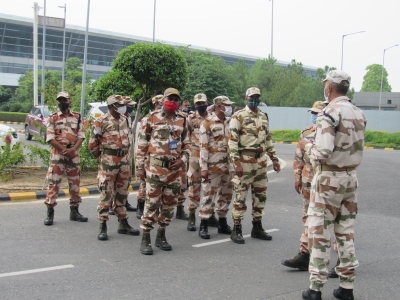By D.C.Pathak People think of our defense forces in their magnificent battle dress whenever there is a threat to national safety.They protect the country’s borders from external attacks and win the war for us.
Security has been a matter of war and peace for a long time.All countries, large and small, have maintained an army and sought alliances in order to defend themselves against known enemies.
The Cold War era saw the superpowers trying to outdo one another militarily.Their race for superiority with missiles produced the ultimate deterrence, the Mutually Assured Destruction system (MAD) created by the US.
Open warfare was controlled, but there were also attempts to foment ideological subversion and insurgency to weaken the enemy.However, it was the rise of ‘covert offensives in the post-Cold War period, after the defeat of the anti-Soviet war in Afghanistan that led to the disintegration of the USSR and ended the Cold War, that brought about the era of “asymmetric” warfare.
It is Afghanistan that was again the target of the US’s new terror, after the defeat of one superpower.
Covert offensives using terrorism to cross geographical boundaries have been replaced by open attacks with ‘proxy Wars’.India was the most victim of cross-border terror instigated in Kashmir and elsewhere by Pakistan.
26/11 was India’s 9/11.Pakistan’s ISI used terrorists in a covertly planned attack against Mumbai from the seafront.This war by stealth has separated the distinct dimensions of defence’ and security’, requiring new measures to deal with the advances in weaponry and terrorist technology in both cases.
The threat of Pakistan-sponsored proxy war against India has been exacerbated by the Sino-Pak Axis.Cross-border terrorism was now sustained through the use of drones, a product Chinese technology, for the surreptitious drop of arms and ammunition into the Kashmir Valley and drug transport in the bordering regions of Punjab.
The use of social media for combat and recruitment of terrorists has made it easier for the enemy to do their work.
Both the US and India have made cyber security a central focus of their security strategies.
The importance of cyber security was highlighted at the recent DGPs’ conference held in Lucknow.Prime Minister Narendra Modi attended the entire session over two days.
Two new developments have been made by the threat of terrorist attacks.The induction of Army into counter-terrorist operations on our soil takes the challenge of civil/military cooperation to a whole new level.
And, the Centre and Army have opened the ground for paramilitary forces to work together to secure our borders.
The Army was trained to inflict maximum casualties on the enemy when attacking the country.
It had to be specially trained to keep collateral damages in counter-terror operation to a minimum and present the population as an empathic force.
This is possible because intelligence-based operations aid in this.
That is why the importance of our intelligence infrastructure to maintain internal security has become so critical.Security is protection from the covert actions of the unknown enemy.
It is anchored entirely upon timely information about the location and plan of the latter, which is exactly what intelligence was.
A new extension of proxy war aiming at ‘winning war by other means’ is using civil rights fora to overthrow a democratically elected government through building narratives to influence the unsuspecting population against the ruling dispensation.
Authoritarianism, majoritarianism, and the treatment of minorities could all be easily made on vague grounds to create the impression that the Constitutional mandate was not being respected by the ruling regime.
Influencing the political outcome via non-governmental bodies linked with lobbies at work and abroad is a new phenomenon.
It uses ‘human’ channels to supplement what was being attempted via ‘technology’ online.
In this context, it is easy to grasp the significance of the recent address by Ajit Doval, National Security Advisor, at the ‘passing-out’ function for new IPS officers from the National Police Academy Hyderabad.
He said that civil society was the next frontier of war because it can be used to harm a nation’s interest.It was a ‘fourth generation’ of warfare, which he described as being the finest form of ‘proxy War’.
All those who are responsible for protecting internal security – and the police is often the first to respond – need to be fully aware of the challenges that lie beyond the traditional law and order.
The strategy for internal security must shift to enlarging intelligence capabilities of our police organizations.
There is a strong presence of armed forces in India’s border states, including the Northeast.The deterrence of uniforms exists, but only to a certain extent.
Enemy agents learn to operate by getting around the ‘pickets.
Visibility of force gave confidence and security to law abiding citizens.
This could encourage them to do their part to ensure national security.
It is the adversary’s success in creating an underground network and agents that must be stopped.
The central intelligence agencies’ efforts to uncover this hidden danger must be augmented with intelligence from the state and district intelligence machines in operational cooperation.
Technology that can improve policing must be developed on a priority base.
This was precisely the message that Prime Minister Modi delivered to the Lucknow conference of DGPs.
A greater number of state police officers should be assigned to intelligence functions in vulnerable border states like J&K, Punjab and Mizoram.
Police officers in uniform need to be made aware of activities by fora that play ‘politics-by-proxy’ with external lobbies.This should not preclude legitimate media activities and philanthropic missions.
Only when there is a clear violation the country’s laws should action be taken.
The three current features of India’s security situation are: the adversary’s attempts at radicalization to trap vulnerable elements into the underground terror network; accentuate the majority-minority division to feed communal militancy; and float civil society platforms in order to bring down India on governance issues.
Intellectualized debates have been sponsored on a variety of topics, including putting a questionmark on Indian identity and advocating a place in Indo-Pak negotiations on Kashmir for China because of the Chinese claim to the territory of that country.
The challenge for internal security is to get the police involved as a responder, without allowing any room for politicisation.
(The writer is a former Director at Intelligence Bureau; his views are his own.
pathak/arm #Security #unim #deterrence #Column #Spys #Hyderabad #Mumbai
.







